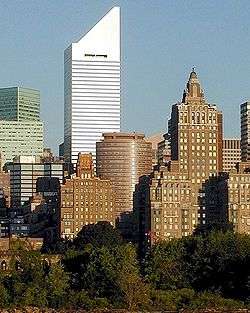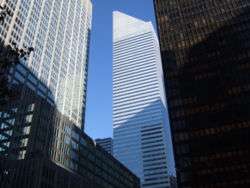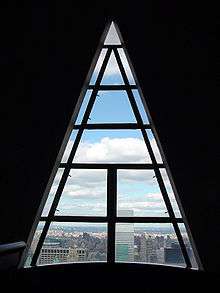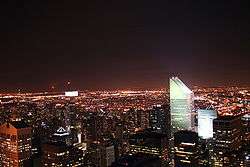Citigroup Center
| 601 Lexington Avenue Citigroup Center | |
|---|---|
 | |
| General information | |
| Type | Office |
| Location | 153 East 53rd Street, New York City |
| Coordinates | 40°45′31″N 73°58′13″W / 40.758533°N 73.970314°WCoordinates: 40°45′31″N 73°58′13″W / 40.758533°N 73.970314°W |
| Construction started | 1974 |
| Completed | 1977 |
| Opening | 1977 |
| Cost |
$195 million (USD) (equivalent to $763 million) |
| Owner | Boston Properties |
| Height | |
| Architectural | 915 ft (279 m)[1] |
| Technical details | |
| Floor count | 59[1] |
| Floor area | 1,578,883 sq ft (146,683.0 m2) |
| Lifts/elevators | 38 |
| Design and construction | |
| Architect | Hugh Stubbins / KlingStubbins, Emery Roth & Sons |
| Developer | Boston Properties |
| Structural engineer | Le Messurier Consultants, James Ruderman |
| References | |
| [1] | |
The Citigroup Center (formerly Citicorp Center and now known as its address, 601 Lexington Avenue) is an office tower in New York City, located at 53rd Street between Lexington Avenue and Third Avenue in midtown Manhattan. It was built in 1977 to house the headquarters of Citibank. It is 915 feet (279 m) tall, one of the ten tallest skyscrapers in New York, and has 59 floors with 1.3 million square feet (120,000 m²) of office space.
The building is one of the most distinctive and imposing in New York's skyline, thanks to a 45° angled top and a unique stilt-style base. It was designed by architect Hugh Stubbins and structural engineer William LeMessurier. The building is currently owned by Boston Properties, and in 2009, was renamed 601 Lexington Avenue.
History
Context and early engineering details



The northwest corner of the site was originally occupied by St. Peter's Evangelical Lutheran Church which was founded in 1862. In 1905, the church moved to the location of 54th Street and Lexington Avenue.
From the beginning, the Citigroup Center was an engineering challenge. When planning for the skyscraper began in the early 1970s, the northwest corner of the proposed building site was occupied by St. Peter's Lutheran Church. The church allowed Citicorp to demolish the old church and build the skyscraper under one condition: a new church would have to be built on the same corner, with no connection to the Citicorp building and no columns passing through it, because the church wanted to remain on the site of the new development, near one of the intersections. Architects wondered at the time if this demand was too much and would make the proposal unfeasible.
Structural engineer William LeMessurier set the 59-story tower on four massive columns, 114 feet (35 meters) high, positioned at the center of each side, rather than at the corners. This design allowed the northwest corner of the building to cantilever 72 feet (22 meters) over the new church. To accomplish this, LeMessurier employed a system of stacked load-bearing braces, in the form of inverted chevrons. Each chevron would redirect the massive loads to their center, then downward into the ground through the uniquely positioned columns.
The church, at 619 Lexington Avenue with its entrance from 54th Street, has a theatre in its basement which is mainly used by the York Theatre.[2]
Engineering crisis of 1978

Due to a design oversight and changes during construction, the building as initially completed was structurally unsound. For his original design, LeMessurier calculated wind load on the building when wind blew from due north, east, south, or west, blowing directly against one side. He did not calculate wind loads when the wind blew from one of the quarters (northeast, northwest, southeast, or southwest), against a corner. In June 1978, prompted by discussion between a civil engineering student at Princeton University, Diane Hartley, and design engineer Joel Weinstein, LeMessurier recalculated the wind loads on the building, this time including quartering winds.[3] This recalculation revealed that with a quartering wind, there was a 40% increase in wind loads and a 160% increase in the load at all connection joints.
LeMessurier's original design for the "chevron" load braces used welded joints. However, during construction, to save labor and material costs, builders used much weaker, bolted joints—a change made after city approval of the plans. The original welded-joint design had ample strength to withstand the load from straight-on wind, with enough safety margin to withstand the higher loads from quartering wind; however, the load from a 70 miles per hour (110 km/h) hurricane force quartering wind would exceed the strength of the bolted-joint chevrons. The bolts could shear and the building could collapse. Wind tunnel tests with models of Citigroup Center revealed that the wind speed required to bring down the building occurred on average once in 55 years.
For occupant comfort, the building has a tuned mass damper, which also negates much of the wind load. If electric power failed, say during a hurricane, the damper would shut down and a much lower-speed wind would suffice; wind of this speed occurs on average once in 16 years. LeMessurier also discovered that his firm had used New York City's truss safety factor of 1:1 instead of the column safety factor of 1:2. These factors, combined, put the building in critical danger. The problems were discovered in June, the beginning of hurricane season, and had to be corrected quickly.[4]
LeMessurier reportedly agonized over how to deal with the problem. If the issues were made known to the public, he risked ruining his professional reputation. He approached the architect (Hugh Stubbins) first, and then Citicorp. He advised them to take swift remedial action. Ultimately, he persuaded Citicorp to repair the building without informing the public, a task made easier by a press strike, then going on.[4]
For the next three months, construction crews working at night welded 2" steel plates over each of the skyscraper's 200 bolted joints. They worked during the night, after each work day, almost unknown to the general public. Six weeks into the work, a major storm (Hurricane Ella) was off Cape Hatteras and heading for New York. With New York City hours away from emergency evacuation, the reinforcement was only half-finished. Ella eventually turned eastward and veered out to sea, buying enough time for workers to permanently correct the problem. As a precaution, Citicorp did work out emergency evacuation plans with local officials for the immediate neighborhood.[4]
Because nothing happened as a result of the engineering gaffe, the danger was kept hidden from the public for almost 20 years. It was publicized in a lengthy article in The New Yorker in 1995.[5]
Ethical questions
Architect Eugene Kremer has discussed the ethical questions raised in this case.[6]
LeMessurier was criticized for insufficient oversight leading to bolted rather than welded joints, for not informing the endangered neighbors, for actively misleading the public about the extent of the danger during the reinforcement process, and for not informing other architects about the problem and solution for two decades.[6] However, his act of alerting Citicorp to the problem in his design is now used as an example of ethical behavior in several engineering textbooks.
Kremer discusses six key points:[7]
- Analysis of wind loads. Check all calculations and not rely just on building codes; these set minimum requirements and not the state of the art.
- Design changes. In this case change from welded to bolted connections. Changes are considered in the overall design context and by everyone involved and not a spur of the moment decision.
- Professional responsibility. To follow the codes of conduct for every chartered institution. LeMessurier did not consider the public safety first.
- Public statements. In this case the public statements issued by LeMessurier and Citigroup set out to mislead the public deliberately.
- Public safety. The public statement denied the public the right to ensure their own safety and to make their own critical decisions.
- Advancement of professional knowledge. Concealing this problem for almost 20 years prevented ethical and engineering learning that could have taken place.
Sale and name/address changes
Former Citicorp Chairman Walter B. Wriston was reportedly behind the decision to acquire several low- and mid-rise buildings in the area, supposedly to buy out massage parlors and mom-and-pop stores in Midtown.[8] In 1987, Citigroup sold two-thirds of its interest in the building, along with one-third of its interest in 399 Park Avenue, to Dai-Ichi Mutual Life Insurance Company for $670 million (total cost of building adjusted for inflation: $365,584,843).[9] In 2001, Citicorp sold its controlling stake in the building for $755 million (cost of building adjusted for inflation: $569,794,069) to Boston Properties. Citigroup relocated its headquarters to 399 Park Avenue.[10][11]
In 2008, building owner Boston Properties began the process of renaming the tower "601 Lexington Avenue".[12] Renovation of the lobby resulted in relocation of the tower's entrance from 53rd Street to Lexington Avenue.[13] All signage for Citigroup was removed from the building and surrounding block. The name change became effective in 2009.[14][15] The company is also considering selling naming rights to the building.[16]
Notable features
- The roof of Citigroup Center slopes at a 45-degree angle because it was originally intended to contain solar panels to provide energy. However, this idea was eventually dropped because the positioning of the angled roof meant that the solar panels would not face the sun directly.
- To help stabilize the building, a tuned mass damper was placed in the mechanical space at its top. This substantial piece of stabilizing equipment weighs 400 tons (350 metric tons). The damper is designed to counteract swaying motions due to the effect of wind on the building and reduces the building's movement due to wind by as much as 50%.[17] Citigroup Center was the first skyscraper in the United States to feature a tuned mass damper.
- The building features double-deck elevators, which are separated to serve only odd or even floors.
- The corporate headquarters of Citigroup, contrary to popular perception, are not located in the building, but across the street in 399 Park Avenue.
- In 2002, one of the columns was reinforced with blast resistant shields of steel and copper as well as steel bracing to protect the building due to the possibility of a terrorist attack.[18]
- From 1987 to 2009, the bank presented an annual toy train exhibition in the lower lobby.[19]
In popular culture
The building is visible in numerous television shows and movies (often as part of a wider panoramic shot of New York City), notably during the opening credits of the long-running NBC police procedural and legal drama Law & Order, and it can also be seen in the background of the opening titles of the 1980s sitcom Taxi.
A season one episode of the TV show NUMB3RS, "Structural Corruption", involves a fictional building with faults almost exactly paralleling the crisis of the Citigroup Center. Like the Citigroup Center, a college student studying the fictional Cole Center finds the building to have inadequate strength when subjected to quartering winds. However, the insufficient welds in the Cole Center lie in the foundation, and a tuned mass-damper (not present in the original construction) is added to make the building safe.
The building's architectural design and history were the feature of episode 110, "Structural Integrity", of the podcast 99% Invisible.[20]
See also
- Citicorp Building
- List of tallest buildings in New York City
- List of tallest buildings in the United States
References
Notes
- 1 2 3 "Citigroup Center - The Skyscraper Center". Council on Tall Buildings and Urban Habitat. Archived from the original on 2012-06-15.
- ↑ Our Venue, York Theatre
- ↑ "OEC - Addendum: The Diane Hartley Case". Onlineethics.org. Retrieved 2014-08-24.
- 1 2 3 Werner, Joel. "The Design Flaw That Almost Wiped Out an NYC Skyscraper". Slate (magazine). The Slate Group. Retrieved 17 April 2014.
- ↑ Joe Morgenstern (1995), "The Fifty-Nine-Story Crisis", The New Yorker, May 29, 1995. Pages 45–53.
- 1 2 Eugene Kremer (2002). "(Re)Examining the Citicorp Case: Ethical Paragon or Chimera", Cross Currents, Fall 2002, Vol. 52, No 3.
- ↑ "Norbert J. Delatte, ''Beyond Failure: Forensic Case Studies for Civil Engineers'', p 340". Books.google.co.uk. Retrieved 2014-08-24.
- ↑ Robert A.M. Stern, David Fishman and Jacob Tilove. New York 2000: Architecture and Urbanism Between the Bicentennial and the Millennium
- ↑ Berg, Eric N. (1987-10-03). "Citicorp Selling Part Offers Headquarter". New York Times. Retrieved 2009-09-04.
- ↑ "Citi Doesn't Live Here Anymore as Name Comes Off NYC Skyscraper". Bloomberg. 2008-12-12.
- ↑ "Boston Properties Continues Efforts to Acquire Citigroup Center - re> BOSTON, March 28 /PRNewswire/". Prnewswire.com. Retrieved 2014-08-24.
- ↑ Dana Rubinstein (2008), ‘Citigroup Center’ To Become Scintillating ’601 Lexington Ave’, The New York Observer, December 12, 2008.
- ↑ ""Jones Lang LaSalle to Lease Renamed 601 Lexington Avenue"". Us.am.joneslanglasalle.com. Retrieved 2014-08-24.
- ↑ Boston Properties Announces Second Quarter 2009 Results.
- ↑ Frank Stella at the Atrium Shops and Cafes at Lexington Avenue and 53rd Street, New York, NY (Formerly Citigroup Center).
- ↑ BNET Boston Properties to rename 601 Lexington Avenue.
- ↑ Greer, William R. (October 24, 1982). "Rx for Swaying Skyscrapers". The New York Times. Retrieved 2009-07-25.
- ↑ O'Driscoll, Patrick (September 25, 2002). "High-rises remain vulnerable after 9/11". USA Today. Retrieved 2010-04-11.
- ↑ Citi Derails Holiday Toy-Train Show in Credit Crunch Bloomberg News, Dec 9, 2008
- ↑ Mars, Roman (15 April 2014). "Structural Integrity". 99% Invisible. Retrieved 23 April 2014.
Sources
- Dirk Stichweh: New York Skyscrapers. Prestel Publishing, Munich 2009, ISBN 3-7913-4054-9
- Horsley, Carter B. The Midtown Book, The City Review
- PBS's "Building Big" Series
- A Potentially Disastrous Design Error by Alan Bellows
External links
| Wikimedia Commons has media related to Citigroup Center. |
- Citigroup Home Page
- Citigroup Center on CTBUH Skyscraper Center
- Emporis